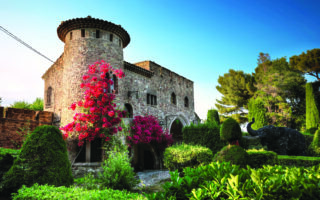Famous French Figures: King Louis XIV
Louis XIV, the ‘Sun King’, was king of France during a time of prosperity and left a legacy of art and architecture, including the iconic Palace of Versailles
Early Life of Louis XIV
Louis XIV was born on 5 September, 1638, and died in the same month 77 years later. Because he inherited the throne at the age of four he had the longest reign of any European monarch, giving him time for some notable achievements. The foremost of these was the Palais de Versailles. It brought a fundamental change in the working of French government as Louis moved the entire court out of the centre of Paris and took over the running of affairs of state, rather than rely on Chief Ministers.
Most of Louis’s life was spent in and around Paris. He was born in the Château de Saint-Germain-en-Laye, but the family moved soon after into the Louvre. After his father Louis XIII’s death his mother, Anne of Austria, opted to live in the Palais-Royal, because she found the Louvre uncomfortable, particularly in winter. It was a short distance from the home of Louis’s tutor, Nicolas V de Villeroy, where the young king and his brother played with the de Villeroy children, who became lifelong friends.
Louis was rather neglected as a child. There is a story that he was rescued from drowning in a garden pond because he had been left to his own devices. The country was run during his minority by the chief minister, Cardinal Jules Mazarin, who was hugely unpopular with the nobility and judiciary. Counting against him was his Italian birth and his continuation of policies begun by Cardinal Richelieu, intended to weaken the influence of the nobility and curtail the power of the law.
Reign of Louis XIV
The discontent with Mazarin led to the Fronde, civil wars that raged for five years from 1648, ending only when factions backing the monarchy exploited divisions in the opposition. The poverty, humiliation and fear that Louis felt at that time made him determined to hold the reins of power and keep the nobility beholden to him. From the age of 23, following the death of Mazarin, he controlled everything, from manners at court to military campaigns and the organisation of France’s infrastructure.
The absolute monarch’s interest in the arts, architecture and culture led to a flourishing of theatre, painting and music, and the creation of impressive buildings in and around Paris. He ordered the construction of L’Hôtel National des Invalides, as a refuge for veterans and wounded soldiers who had worn the king’s uniform, so that they would not end up destitute, having served their country.
Achievements of Louis XIV
He established the Academy of Painting and Sculpture and the Academy of Architecture, and allowed writers such as Voltaire and Racine to thrive. On a practical level, Louis encouraged manufacturing, created a merchant navy and a modern police force, improved ports, roads and canals. He renovated the royal palaces, ordered the creation of pleasure gardens and, over 40 years, fulfilled his ambitions to live surrounded by beauty by turning a modest hunting lodge just south of Paris into the dazzling Palais de Versailles.
Eventually all good things come to an end, and it was the king’s devout Catholic beliefs that alienated his people. He revoked the rights of Huguenots in France, and closed Protestant schools and churches, forcing the children to be educated as Catholics. This led to many skilled artisans leaving the country. He also involved France in the War of the Spanish Succession, which had little to do with them but put the country in debt.
After he died of gangrene at Versailles on 15 September, 1715, his body was transported to the Basilica of Saint-Denis to jeering from the inhabitants of Paris. His body was interred there until the French Revolution, when the church was vandalised and the remains of many French monarchs were unearthed and scattered. A sad end for a king who shone so brightly for so long.
PLACES TO VISIT TO LEARN MORE ABOUT LOUIS XIV
Louis XIV’s outstanding legacy began as the expansion of a hunting lodge in 1661. It was said the king wanted a discreet place to meet his mistress Louise de la Vallière. By 1682 Versailles was Louis’ principal residence and centre of government, and today it is one of France’s premier tourist attractions and is a UNESCO World Heritage Site.
Musée d’Archéologie Nationale, Saint-Germain-en-Laye
Louis XIV’s birthplace, the Château de Saint-Germain-en-Laye, lies about 15 kilometres north-west of Paris. It now houses the national archaeological museum and contains 30,000 exhibits from the Bronze and Iron Ages, and Roman and Merovingian Gaul.
Palais-Royal/Hôtel de Villeroy, Paris
These two buildings featured prominently in Louis XIV’s childhood. The ‘village in the city’ now accommodates the Comédie Française, the Palais-Royal Theatre, a courtyard to stroll in, shops and restaurants. A ten-minute walk away is the Hôtel de Villeroy, where Louis’s tutor, Nicolas V de Villeroy, lived and the future king played with François de Neufville de Villeroy, who became a lifelong ally.
L’Hôtel National des Invalides, Paris
This complex was built by Louis XIV as a hospital for wounded soldiers and a home for military veterans, a function it continues to fulfil today. The complex is enormous, with a 196-metre-long façade, 15 courtyards and a chapel. Attractions include an army museum, Napoléon’s tomb and the Musée des Plans-Reliefs.
Like this? You might also enjoy:
10 Paris museums you can visit for free
Share to: Facebook Twitter LinkedIn Email


